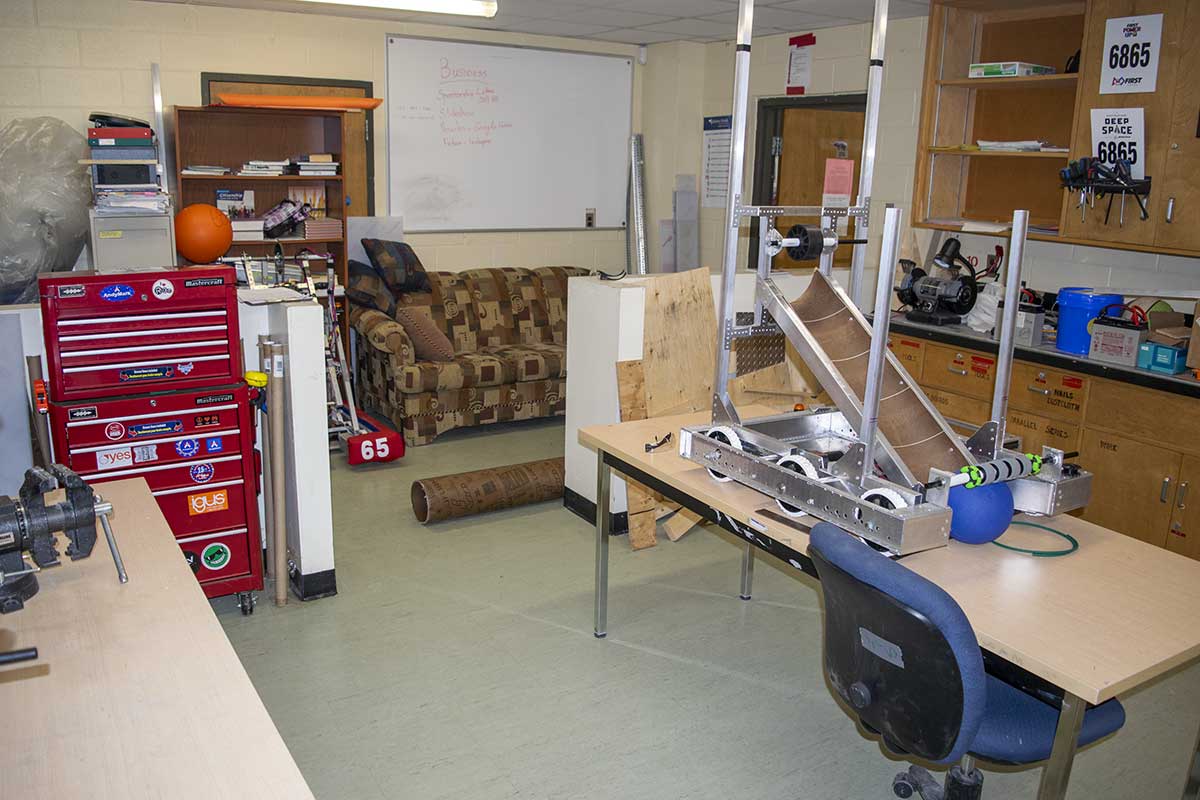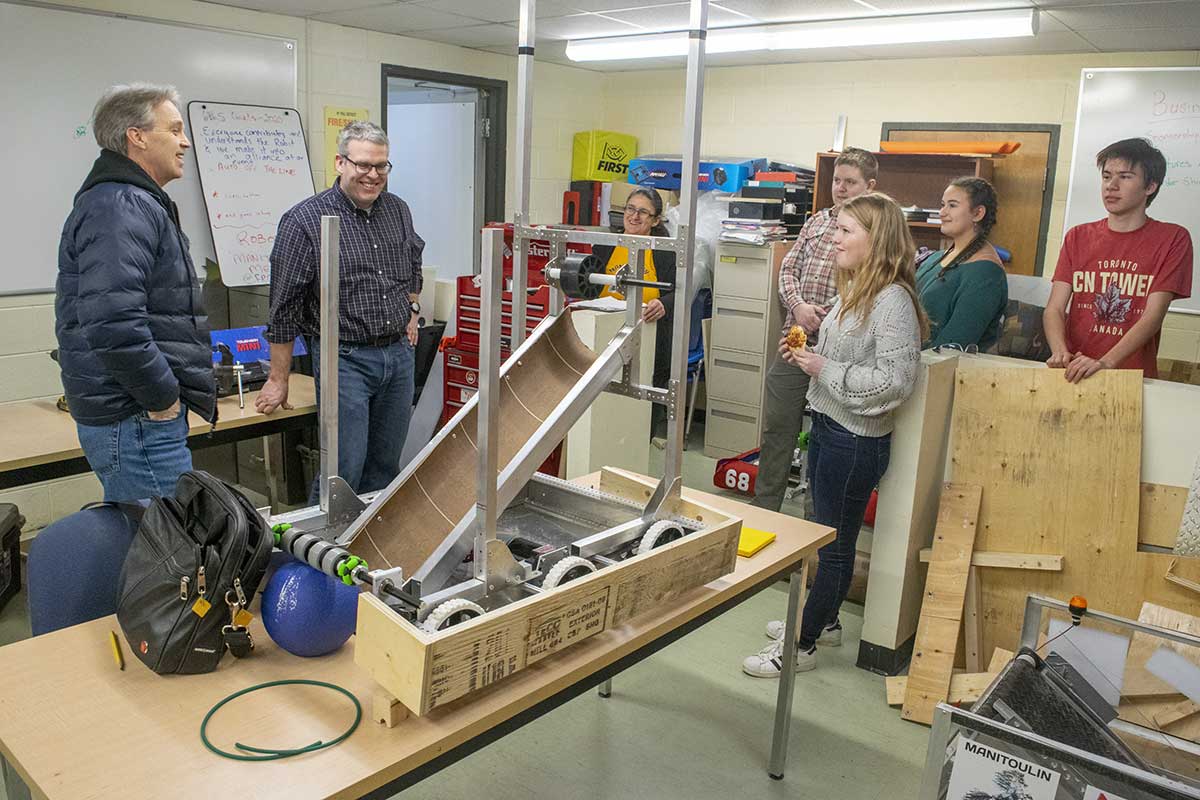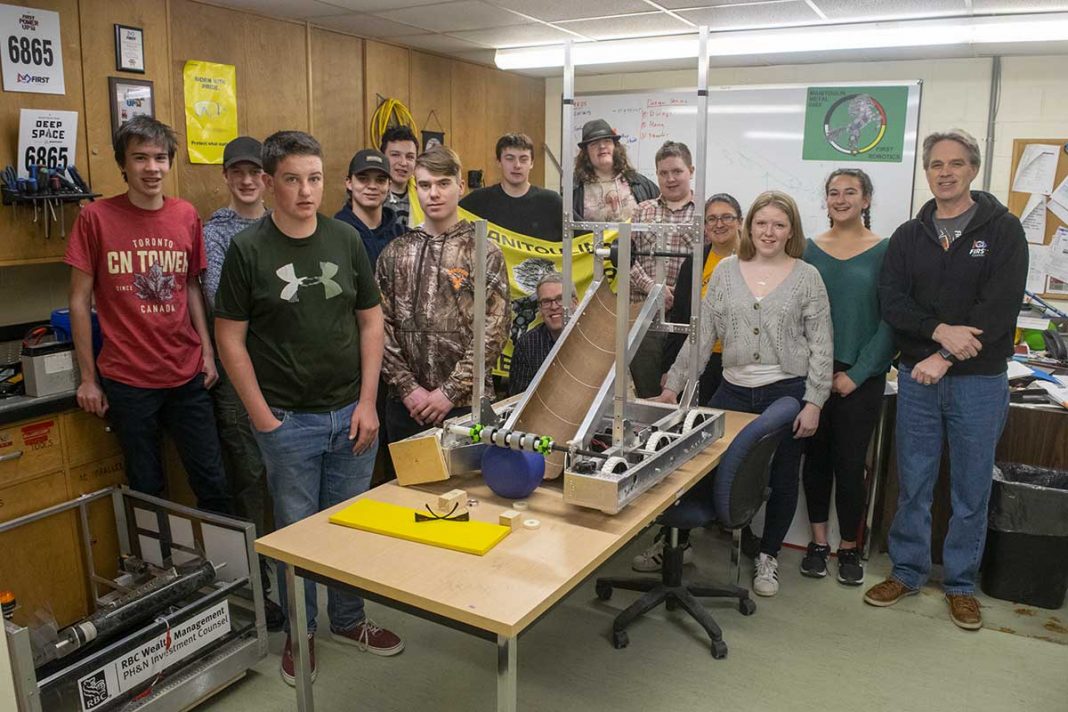BILLINGS – Thursday, February 6 is a day like any other at Manitoulin Secondary School (MSS), except for a group of students that has gathered within the school’s makerspace over their lunch hour. The thread that links them all? Each has a role on FIRST Robotics Canada (FRC) team 6865 – Manitoulin Metal, a relatively new team full of innovators, problem-solvers and skilled workers who collaborate with teacher mentors to design, build and test robots that will be used in competitions with similar teams across the country.
Team 6865 works on its robot builds in the school’s makerspace, hosted in one of the far corners of the building’s ground floor. From the main hallway it appears as any other school room. But immediately behind the unassuming wooden door lies a small workshop no more than 300 square feet in size where innovation, ingenuity and imagination combine.
The eye’s focus jumps quickly between eclectic elements within the workshop. A teacher’s desk in the back corner is covered by several layers of paperwork, errant pieces of metal and, somewhere beneath the collage, a computer. Plywood scraps of various sizes lean against a wall, waiting to find the perfect home within a forthcoming build. Batteries, loaned power tools and piles of textbooks socialize on busy countertops. A concrete-forming tube two metres in length lies on the floor next to an old couch, which rounds out the collection.
But the centrepiece of it all is a table in the centre of the workspace that supports a contraption of metal framing, wheels, axles, motors, rollers and a length of said concrete-forming tube. It’s Team 6865’s ongoing build for this year’s FRC competition circuit.
The in-progress machine has company in the room, in the form of last year’s robot. It’s still fully functional (for use both as a demonstrator and as an emergency backup bot in case the ongoing teachers’ union job action means after-school build progress has to halt) and is parked at attention near the entrance door, as if to offer a daily inspirational reminder of the abilities of high schoolers.
A robot from 2018, MSS’ first year with an FRC team, also rests in the workshop space. It, however, is not in as good condition as its successor. After all, the inaugural bot had many useful components that could be repurposed for the builds of future years to save on costs and the effort of re-engineering proven solutions.
• • •
Team 6865 business manager Jocelyn Kuntsi, a ninth-grade student at MSS, is among the first of her peers to arrive at the makerspace during the lunch period, followed by a slow but steady stream of her peers. They pass through the small workshop to a wide-open, bright room that doubles as a kitchen and meeting area.
Meeting outside of instructional time is nothing new for these students who spend countless hours during and after school planning and building their machine, as well as the many trips to FRC events which take up full days each season in their travel alone.
The feel of the gathering is as might be expected from a modern group of students, with conversations ranging from noteworthy online content (this 21st-Century team stays connected through, among other media, a Snapchat group) to a challenge to come up with the greatest pun based on a teammate’s name.

Lunch is short so Jocelyn lives up to her title and gets the group down to business.
“I’m putting the team t-shirt orders in tomorrow so if anybody hasn’t put in their order with their name and their spot on the team please send that in on Google Classroom,” she says.
Team mentor Yana Bauer arrives and directs the students who haven’t ordered to use one of the class’ many notebook computers to submit their request.
Students communicating over Snapchat and using personal school laptops to submit information into an online education hub dedicated to the school’s robot-building squad – it’s a world apart of the classroom of even 10 years ago.
• • •
A small burst of activity erupts at the back door that opens outside onto a parking area where a small handful of students call out “he’s here,” step out and return carrying stacks of pizza boxes.
Some parts of the high school experience haven’t changed.
The reason these students have all gathered is more than just a pizza lunch; rather, it’s the presidential purveyor of pizza that has their attention – FRC president Mark Breadner, to be precise. He has long been a supporter of the young team and decided to take up Team 6865 lead mentor Allan Davy’s invite to visit the school.
Mr. Breadner enters the meeting room and appears instantly at ease with his surroundings. His past, after all, includes a posting as the director of robotics for the Toronto District School Board and the founding of the inaugural FRC team in 1998 at a Toronto high school, as well as numerous awards and accolades for his mentorship.
He also has learned a secret weapon for instantly forging connections with high school students.
“I try to do a few road trips a year, and I always show up with pizza,” he tells The Expositor with a laugh.

Not that he needs the help. As the boxes get opened, he strikes up conversations with the team members about all manner of topics—the optimal kind of truck for a Northern Ontario lifestyle, the progress of an under-construction snowmobile trail nearby and a dive into the various roles and interests of the students.
• • •
Mr. Davy and Mr. Breadner step aside into the workshop with Ms. Bauer as the students enjoy their meal so the MSS team mentors can show the FRC president this year’s build.
Mr. Davy remarks that the previous years’ team members have all graduated, and this year’s team is rather young.
“That’s the life blood of a team, Grades 9 and 10,” said Mr. Breadner, and Mr. Davy nods.
“That’s why we’re putting so much time in this year to teach them about riveting, soldering, because come build season you need that,” said Mr. Davy.
The three adults switch to a discussion about various products involved in the build, their strategies and how they feel about recent changes to FRC rules. Mr. Breadner adds to the discourse by referencing other schools he has visited and their own journeys.
He always refers to each team by its four-digit number alone, but occasionally adds the teams’ geographic locations as secondary information for the others who don’t have an internal team directory in their brains. With more than 200 FRC teams in Ontario district, let alone the rest of the country or the FIRST Lego League, it’s a lot of information to maintain.
• • •
As the discussion continues, a handful of students trickle into the workshop from the meeting room, slices in hand. Mr. Breadner asks about the team’s plans to keep their momentum going into future years, to which build captain and driver Lindsay Sheppard, a Grade 10 student, replies the recent addition of FIRST Lego League to the feeder elementary schools on Manitoulin Island has been a boost.
“Two weeks ago, we had a shadow day where the Grade 8 students came here and they got a chance to see and drive our robot,” she said.
“That’ll help, for sure,” Mr. Breadner replies, leaning on a countertop.
Running an FRC team in a rural location comes with a unique set of challenges. Travelling to compete at meets requires a considerable amount of time and planning to get the team and its creation to the matches safely and on time.
Even co-ordinating time to work on the project is challenging. All 419 MSS students are bussed from their homes, which may be up to an hour away from the school. Late buses only run two nights per week and those only let the students stay as late as 5 pm. Opportunities for high school students to mentor the next generation of FRC challengers are greatly limited by those time constraints.
Fortunately, Manitoulin Island residents tend to be strong supporters of community efforts and initiatives. Several Island contractors have loaned out their power tools for use by the team, although Mr. Davy always ensures the students first try those tasks using manual devices so they have a better appreciation of what the power tools offer.
One notable Island business that has sponsored the team is Manitoulin Transport. A vice-president from the company has reviewed the team’s safety manual and stated that it was on the level of an industry standard. Through that review, the team also got pointers about how to bring it to a world-class level.
That was great news for Mr. Breadner, who said FRC is very focused on providing safe learning opportunities for students.
“You’re doing great stuff here. Some of the challenges your team faces are not the same for everybody else, but you’re fighting through them,” he said. “The kids up here are brilliant but they don’t have the same opportunities.”
The fledgling team has also garnered sponsorships from the likes of major companies such as Microsoft, Argosy Foundation and RBC, which FRC helped to arrange in an effort to offset some of the rural and Northern challenges Team 6865 faces.
• • •
Canada faces a major workforce challenge in a skilled trades shortage that is forecast to grow worse in the coming years. Mr. Breadner said FRC could be a catalyst for addressing that problem with the next generation because students are getting exposure to numerous new fields in a fun, engaging way through robotics. These subjects range from coding to electrical work, riveting and small machinery operation and maintenance.
The way FRC is designed also supports an enriched learning environment. All aspects of the competition have collaboration in mind. During meets, it is a regular occurrence to see members of one team going to their opponents’ pit area and offering supplies or expertise to get each side’s robots working at their best.
“It’s called Gracious Professionalism. You don’t see that elsewhere and it’s one of our core values. It’s not about winning at all costs, it’s how you compete. Everybody wants to compete at their best, and they can only really do so if their opponent is at their best, so it makes sense to work together like that,” said Mr. Breadner.
The robotics program has been used for capacity building in a similar way within MSS itself. Mr. Davy, who is a student success teacher at the high school, has been able to translate robotics into a credit recovery pathway for students who are struggling in tech classes.
For those getting ready to leave high school for post-secondary education, the MSS program has also been used as an introduction to possible schools.
“If we have students that are thinking about applying to a particular school, when we’re deciding which competitions to enter in we might consider going to a tournament at one of their preferred schools so they can see around campus and get a feel for the environment,” said Mr. Davy.
Supports also go in the opposite direction, to the elementary level, like the Grade 8 shadow days described by Lindsay. Ms. Bauer mentioned that the MSS robotics squad was thinking about launching a one-week summer camp for children in Grades 5 through 8 to learn about FRC and how it differs from the FIRST Lego League of which the elementary students may be a part.
Mr. Breadner was all ears at this possibility and said he would love to see a program of that nature in existence.
• • •
With more than 30,000 students, 2,000 volunteers and 2,000 teacher mentors throughout FRC, there have been many success stories about life-changing experiences through robotics. Mr. Davy said the program offers no shortage of transferrable skills from teamwork to leadership and communication.
He and Ms. Bauer shared the story of Emily Savage, a student who designed the team’s logo back in 2018 as part of a contest. Later, she decided to see what work her logo was being used for and was captivated by the world of robotics. She joined up and went on to become a very successful robot driver for Team 6865.
Ms. Savage has since followed those aesthetic dreams—she obtained a certificate in film production from Weengushk Film Institute, located less than 10 minutes from MSS, and aspires to open a film company based on the Island.
Long after the students had to return to class, the teacher-mentors were still talking with Mr. Breadner in the workshop. He, too, soon had to depart as he was heading to visit Team 5672 (or, as others might say, the FRC team based at Wikwemikong High School) on the continuation of his Northern Ontario road trip.
Team 5672, First Nations STEM, is an all-Anishinaabe team headed by mentor Chris Mara which was founded in the 2014-2015 school year. The team has since gone on to win several awards and, just last year, was ranked among the top three of hundreds of FIRST Robotics teams around the world.
Mr. Davy credits Mr. Mara for his steady encouragement and motivation that the MSS team ever came into being. Indeed, Manitoulin Metal 6865 might not be in existence without the mentoring and support from Team 5672.
• • •
The story of robotics on Manitoulin Island is, in many ways, a projection of the values on which FRC prides itself: working together to build each other up, innovating new solutions, direct and indirect learning and inclusion and diversity.
“I’m very pleased to be able to visit these teams. I’m proud of the teachers and students; they’re doing amazing work and it’s making a difference in so many kids’ lives. (At FRC), we love being able to support that,” said Mr. Breadner.
Through the efforts of team leaders, parent and community supporters and, of course, the dedicated students themselves, the two high schools of Manitoulin Island have proven that greatness can be achieved despite the challenges that one must overcome.
As this year’s Manitoulin team members put the pieces of their robots together and prepare for their first challenges at the regional qualifiers in March, there is a sense of duty and purpose present in their actions.
These students’ successes will define the successes of those next groups, and the future challengers will have their predecessors to thank for building a base. Now, the friendly “co-operation,” as FRC describes it, can begin, with each cohort trying to best the old records of former teams.




